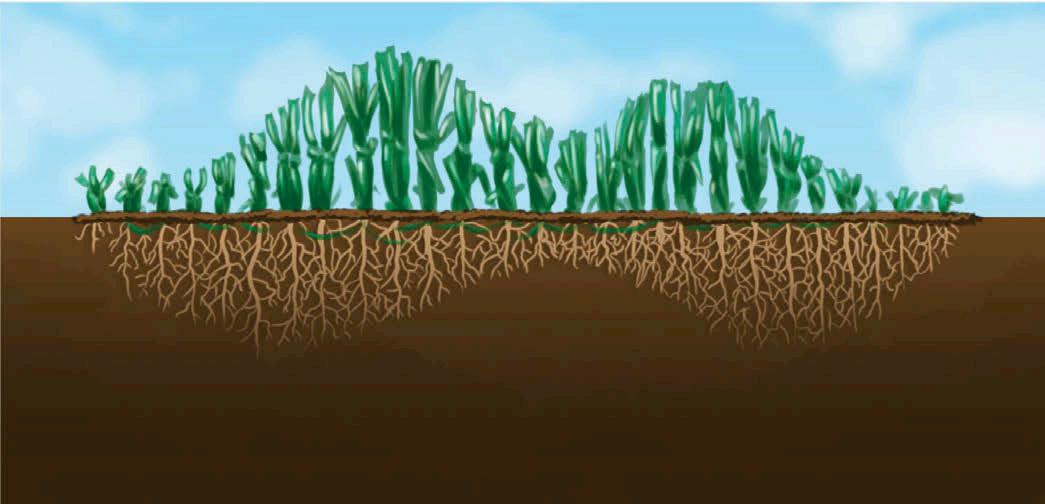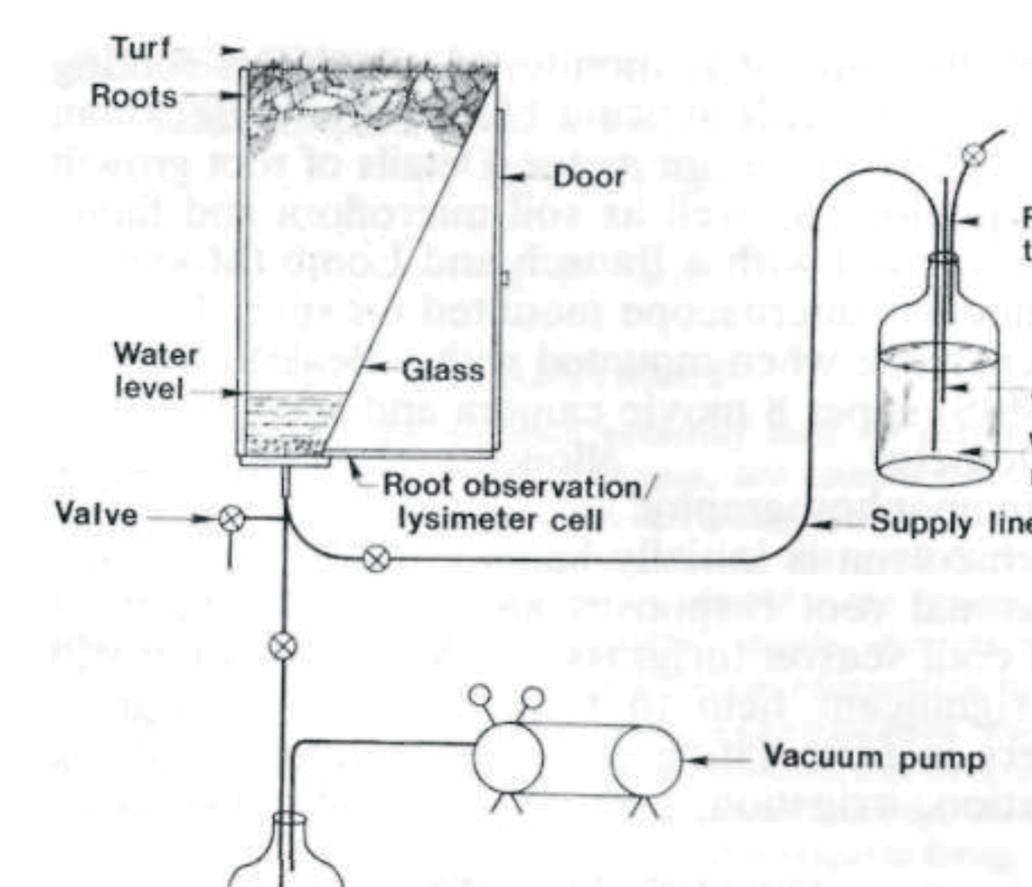
7 minute read
Rooted in Research—Data Driven Growth
ROOTED IN RESEARCH
DATA DRIVEN GROWTH: MODELING FACTORS AFFECTING KENTUCKY BLUEGRASS AND TALL FESCUE LEAF AND ROOT GROWTH
By Cale A. Bigelow, PhD
It’s time for another installment of “Rooted in Research,” where we take a deep dive into turf research you can use or at least gain an appreciation for the science behind the art of turf systems management. Increasingly turf managers are interested in using data to help implement management decisions. This is especially true with respect to timing cultural inputs to manage/promote shoot production or anything that might enhance root growth/health. For this article I pondered the question, “How do cool-season grasses grow?” and dug into the classic vinyl LP section of the turfgrass literature. In my search, I identified three experiments that studied key factors affecting tall fescue and Kentucky bluegrass leaf and root growth.
Question #1: How does temperature affect leaf growth of diverse populations of tall fescue?
(Nelson et al., 1978). In this experiment the researchers knew that, in general, total above ground leaf biomass was controlled by the leaf growth rate and length of time and temperature with a previously reported temperature optimum of about 77 degrees F (25 degrees C). It was also reported that leaf growth responses were more affected by changes in daytime than nighttime temperatures. What was not well studied, however, was how much of a difference there was among plants collected from different geographic regions. From a practical standpoint, plants capable of producing a lot of biomass may require more frequent mowing. Alternatively, these might be just what an athletic field manager may desire because they might be more traffic tolerant. Further, if the plant grows more vigorously in cold or warm weather, this could be very desirable in certain situations.
So, researchers collected plants from Mediterranean, Continental Europe as well as some experimental lines including a selection from the transition zone (Missouri) of the USA. They subjected the plants to a range of temperatures (50, 59, 68, and 77 degrees F) (10, 15, 20, and 25 degrees C) with a 16 hour daylength as well as a cooler temperature, 46 degrees F (7.78 degrees C), with an eight hour daylength. They then painstakingly measured “leaf elongation rates,” by watching for when collar formation occurred on select new leaves and measuring the distance from the collar to the leaf tip for various leaves as they emerged each and every day. This information was then mathematically manipulated to determine leaf elongation rates. Not surprisingly, what they found was that tall fescue leaf area, weight, and elongation rate were highest at 68 or 77 degrees F (20 or 25 degrees C) with a 16 hour daylength that steadily decreased with decreasing temperature. They also found that there were different responses to temperature among tall fescues from different geographic regions. The authors suggested that these differences may be useful when breeding tall fescues for use in different climates. For example, if you planned to plant tall fescue in a warm-humid/transition zone and need vigorous growth in late-spring or summer, cultivars developed from plants native to a warmer region may be more appropriate.
Question #2. Can Kentucky bluegrass root growth be predicted by using a degree-day accumulation technique?
Researchers in Central Ohio (Koski et al., 1988) were interested in how soil temperature changes from January to June affected spring root growth. Prior work reported that 60-70 percent of the bluegrass plant’s total seasonal root growth occurred during those months. For this study, they were interested in how much rising spring soil temperatures affected root growth. The field experiment was conducted in the Ohio State University Rhizotron facility.



Figure 2. Diagram of the rhizotron experimental laboratory from: Karnok and Kucharski “Design and construction of a rhizotronlysimeter facility at The Ohio State University.”
You might ask, what the heck is a Rhizotron? Briefly, a rhizotron is a below-ground laboratory facility that allows for the ability to continuously observe roots and factors affecting root growth without destroying the plant and under a field environment setting. Grasses are planted in small cells containing a consistent rootzone media, often a porous sandy media. In the below ground laboratory, each cell has a small door to exclude light and the door opens to a slanted glass root observation window. As roots grow down, they encounter and imprint themselves on the glass, allowing researchers to observe and measure characteristics of interest like root number, appearance/disappearance, length, and diameter. Using the Rhizotron, researchers can manipulate above ground cultural inputs like mowing height and fertility, or study below ground factors like rootzone temperature. In the present study, researchers monitored the effect of soil temperature at 4 inches (10.16 cm), for three winter-spring seasons on ‘Baron’ Kentucky bluegrass. The intent was to develop a mathematical model to predict how roots might change based on temperature. They found that 15 percent of root production occurred from January to March, 40 to 45 percent during April and May, and the remaining 40 percent in June, with a high correlation (95 percent) of root growth to rising spring soil temperatures. Based on their model, they suggested that monitoring soil temperature could be used to optimize cultural input timings like water or nutrient applications to enhance use and uptake efficiency.
Question #3. Can tall fescue leaf appearance be modeled based on environmental data?
In this experiment (McCarty et al., 1991) researchers wanted to develop a mathematical model to help determine and predict leaf appearance/growth; building on the research conducted in question #1 (Nelson et al., 1978). These scientists wanted to better understand how photoperiod, temperature, plant age, and duration of exposure might be affecting leaf growth. The researchers’ methods were the following: “plants were observed each day (between 0900 and 1000 hr), the youngest leaf tip was tagged by loosely placing a cloth string attached to a numbered clip at the base of the plant.” Following data collection, a mathematical regression model was developed that predicted (78 percent accuracy) daily leaf appearance using solar radiation, precipitation, soil moisture, maximum/minimum air temperature, and leaf age. They also measured soil temperature at 4 inches (10.16 cm) but found that data did not correlate well with leaf appearance. The authors surmised that this type of model could be used to identify rate limiting steps for leaf growth and/or to implement cultural practices that significantly influence leaf appearance.
What does it all mean?
First, not surprisingly, plant growth rates are strongly affected by temperature and increasing temperatures increased leaf and root growth, at least up to an optimal temperature threshold. BUT …there are substantial differences among species and cultivars. If you’ve heard me talk about advances in species and cultivar selection I often mention, “Better ingredients = better lawns.” Now more than ever it’s important to do your homework to select for optimal species/cultivar performance. Data, from cultivar/variety trials by organizations such as the National Turfgrass Evaluation Program (NTEP), for your specific region can be found online (www.ntep.org). We are increasingly in an era of niche cultivars and breeders continue to develop and introduce superior cultivars for specific situations based on consumer desires. Secondly, these aforementioned studies helped provide a basis for the development of more data driven decision making tools to optimize turf health. Until next time, be well, be safe, and as autumn approaches, be sure to gently feed your cool-season turfgrasses. This will ensure a steady supply of nutrients to help build those all-important carbohydrate reserves.
References:
Nelson, C.J., K.J. Treharne and J.P. Cooper. 1978. Influence of temperature and leaf growth of diverse populations of tall fescue. Crop Sci. 18:217-220. Koski, A.J., J.R. Street and T.K. Danneberger. 1988. Prediction of Kentucky bluegrass root growth using degree-day accumulation. Crop Sci. 28:848-850.
McCarty, L.B., J.R. Haun and L.C. Miller. 1991. Daily tall fescue leaf appearance rate in relation to environmental factors. HortSci. 26:114-117.
Cale Bigelow, PhD, is a professor of Turfgrass Science and Ecology in the Department of Horticulture and Landscape Architecture at Purdue University in Indiana. Mike Fidanza, PhD, is a professor of Plant and Soil Science at Pennsylvania State University, Berks Campus. They are teaming to provide a Rooted in Research article for each issue of Turf News. All graphics courtesy of Cale Bigelow, PhD.










